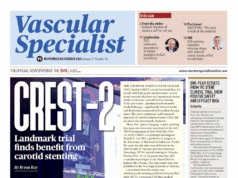Culture is comprised of values, convictions, and practices that have developed over time within ethnic, religious, or geographically distinct societies or groups and have been transmitted over generations.
These traits have enormous impact on how patients behave during stressful states in their life such as chronic illness, and they greatly influence how patients perceive disease, symptoms, expected outcomes, and their relationship with providers of care.

Dr. Ageliki G. Vouyouoka
As vascular specialists, we usually palliate and rarely cure vascular disease, which is a chronic illness. We manage a diverse population of patients and are constantly challenged by cultural diversity. As such, cultural sensitivity is essential if we want to be effective as physicians and interventionalists.
For example, behavioral response to vascular disease is culturally determined. Patients’ symptoms, fear, pain, stress, and what they perceive to be the cause of their illness is often closely associated to their cultural background and biases, as is their degree of collaboration with caregivers during certain treatments.
In some cultures, symptoms are a surrogate for the sickness; as such, once treated and without these symptoms, the patient believes him or herself to be cured. The need for subsequent ongoing management of their disease is not evident to the patient for this very reason. The rationale for continuation of medications, follow up visits and other surveillance, and lifestyle modification seems superfluous now that the patient is no longer “ill.” These beliefs and perceptions clearly affect their compliance. On the other end of the spectrum are fatalistic cultures where chronic disease, where there is no cure, is a reason for doom, with no hope for improvement. With this mentality the negative outcome is inevitable and therefore any therapeutic strategy is considered futile. This pessimistic outlook regarding chronic illness, specifically vascular disease, is also frustrating for the specialist and has the potential for creating animosity and divergence in the patient physician relationship – ultimately rendering suboptimal care.
Family has different meaning in different cultures and, accordingly, may play different roles as a support system in our ethnically diverse patient population. In some cultures, family only includes those in the immediate nuclear family. In other cultures, family extends to include multiple remotely related relatives. In the latter case the challenge for the physician will be to identify the relative we will communicate the most with him or her as representative of the entire family and will be the one to effectively disseminate the information to other members and mobilize everybody effectively towards achieving the best possible outcome for the patient. Some cultures consider the key decision-maker to be the head of the household, someone who might or might not be the patient. Other cultures involve in the decision making process their spiritual leader, even if he is not relative (i.e. rabbi)! Some cultures believe it necessary to “shield” the patient from information that implies a grave or dismal prognostic; as such, these families often prefer that the patient be excluded from discussions of prognosis and certain disclosures related to treatment. Finally, in some cultures, younger members of the family are excluded from decisions in patient care, which can be problematic in cases where their services would be helpful for language translation.
Behaviors associated with communication differ immensely from culture to culture and may challenge how we perceive and interact with our vascular patients and their families. Moreover, in some cultures, behavior towards the vascular surgeon may be shaped by certain biases that exist regarding age and gender as a factor affecting the physician’s ability to provide good medical care. Some cultures regard eye contact as an indication that they are listening and processing the conversation; in other cultures, eye contact is avoided for various reasons – sometimes gender or age related. Some cultures go as far as to believe that it is unacceptable or at least embarrassing to receive medical care from individuals who are younger or of the opposite gender from the patient receiving care.
Not too long ago, I cared for a patient with repetitive TIAs and critical stenosis of his right internal carotid who needed a carotid endarterectomy. He was from Bangladesh. He came dressed in the traditional costume. As he did not speak English, his daughter translated for him. After examining the patient and reviewing the studies, I discussed the merits and risks of carotid endarterectomy and the technical aspects of the procedure with his daughter. The patient was present during the conversation, however, he avoided direct eye contact. Because of this I made minimal effort to directly involve him in the conversation that was mainly carried out between the daughter and myself. His procedure was scheduled.
Despite seeming agreement by the patient and his daughter, his surgery was cancelled and re-scheduled by the daughter three times with little explanation over a relatively prolonged period of time. The patient ultimately sustained a stroke. Only thereafter did his daughter mention that the patient was not comfortable having surgery performed by a female surgeon, that he was very upset that he could not participate in the initial discussions, and, as a result, felt that the power of decision making had been transferred to his young daughter. This was interpreted as a challenge to his authority as the head of his household. The daughter was too embarrassed to discuss this at the first visit or mention this regarding the subsequent cancellations. Eventually, the patient underwent his procedure by a male vascular surgeon, who also spoke his language. Although I could easily identify his vascular concern, I failed to recognize his cultural perceptions and sensitivities. If I had been more aware of these sensitivities during the first visit and had tried to address them with him or at least refer him from the beginning to one of my male partners, I might have prevented his stroke and rendered more effective care.
The patients we treat all have vascular disease that we made a commitment to treat, but the similarity often ends there. Our patient may be old or young, rich or poor, educated or not, from cultures all over the globe – evidenced by a plethora of varying beliefs and practices. It is our responsibility as physicians to understand these differences in core values and biases if we want to treat the patient and not just the disease.
Dr. Vouyouka is a member of the SVS Diversity and Inclusion Committee.












